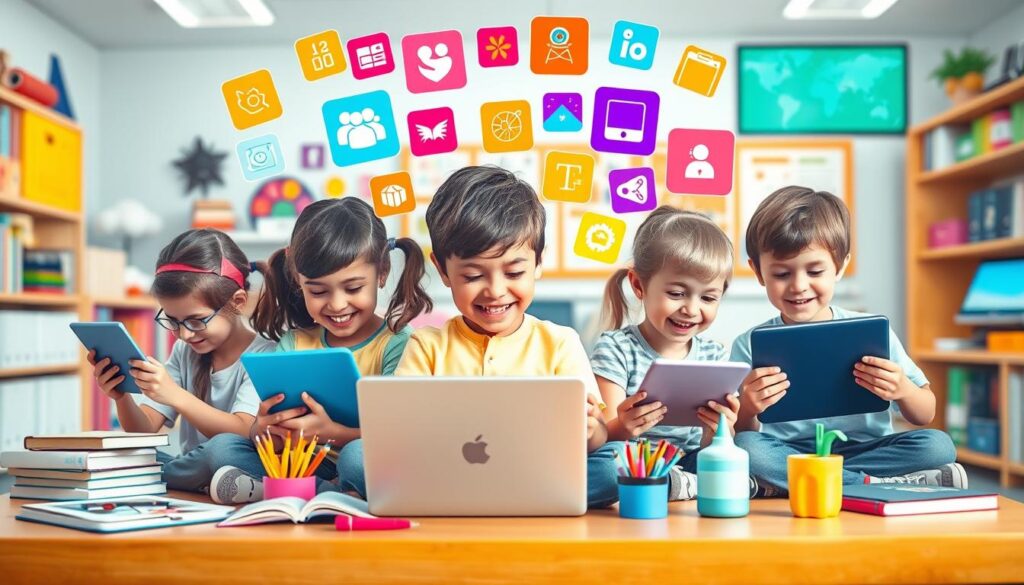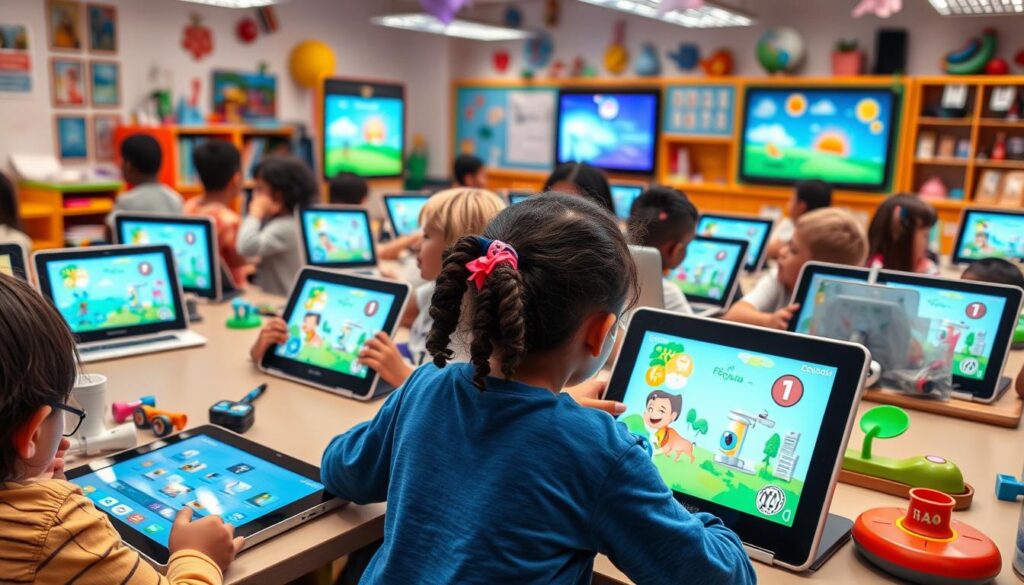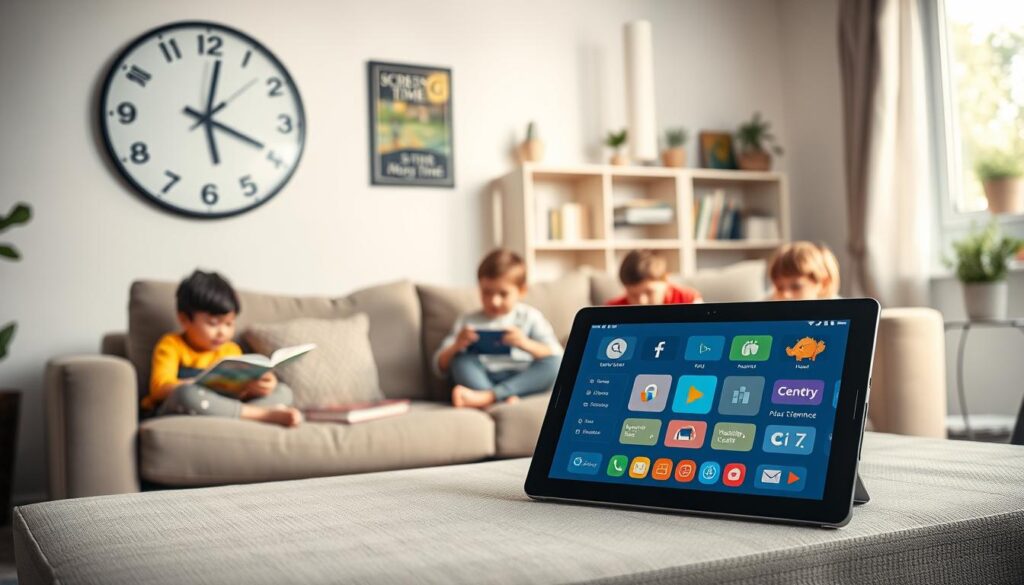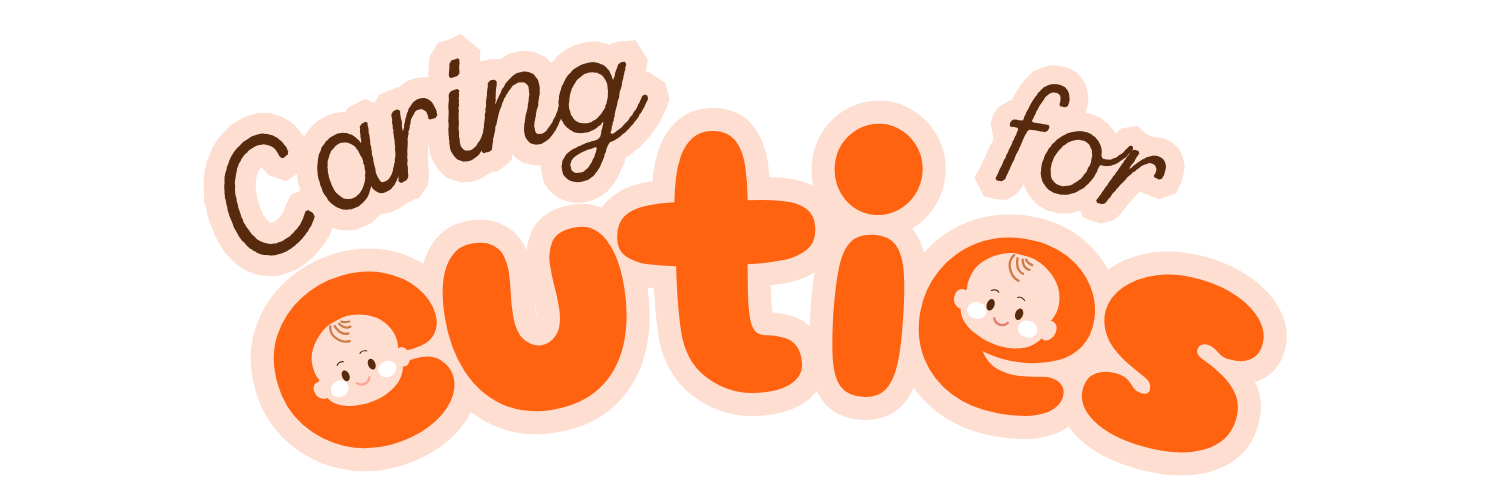What role should digital learning tools for kids play in shaping the minds of future generations? The fast growth of educational technology has changed how kids learn and interact with information. It’s key to think about how these tools can improve learning.

Using digital learning tools for kids has many benefits, like better engagement and learning results. By using educational technology, we can make learning more fun and effective. But, what makes a tool truly effective, and how can we use it to support kids’ learning goals?
Key Takeaways
- Digital learning tools can enhance the educational experience for school-age children
- Educational technology for children can improve learning outcomes and increase engagement
- Effective digital learning tools should be designed with the needs of school-age children in mind
- Parents and educators should be aware of the benefits and limitations of school-age digital learning tools for kids
- By integrating educational technology for children into learning environments, we can create a more immersive and effective learning experience
The Evolution of School-Age Digital Learning Tools for Kids
Educational tools have changed a lot in the last few decades. What used to be textbooks and chalkboards now includes digital platforms. This change makes learning more fun for students.
From Traditional to Digital Learning
Classrooms have moved from old-school setups to digital ones. This change brings new ways to teach and learn. Now, students use interactive online tools instead of just books.
Why Digital Tools Matter in Modern Education
Digital tools help students learn in their own way. They adjust to each student’s learning speed. This helps students understand and remember what they learn better.
The Impact of Technology on Learning Outcomes
Studies show that using technology in schools can help students learn more. It’s not without its challenges, but the benefits are clear. Students get more involved and get feedback right away.
| Feature | Traditional Tools | Digital Tools |
|---|---|---|
| Accessibility | Limited to physical locations and materials | Accessible anytime, anywhere with internet access |
| Personalization | One-size-fits-all approach | Adaptive learning paths tailored to individual needs |
| Engagement | Passive learning through lectures | Interactive online resources for students fostering active participation |
| Feedback Mechanisms | Delayed feedback through graded assignments | Instant feedback and progress tracking capabilities |
Benefits of Educational Technology in Child Development
Using educational apps for school-age children can really help with learning. These apps make kids think critically and solve problems better. This helps them do well in school.
Online tools for kids make learning fun and interactive. When kids enjoy learning, they learn more. They start to learn on their own, which helps them do better in school.
Educational technology also helps kids be creative. They can tell stories digitally or do science experiments online. This lets them explore their interests in new ways.
These digital tools also meet different learning needs. Each child can learn in a way that feels right for them. Many apps let kids work together, which helps them learn to work as a team.
Also, educational technology helps all kids learn, no matter where they are. It gives everyone the chance to get quality education. This makes learning fair for everyone.
| Benefit | Outcome |
|---|---|
| Enhanced Cognitive Skills | Improved memory and critical thinking |
| Increased Engagement | Higher motivation and participation |
| Fostered Creativity | Innovative problem-solving |
| Support for Diverse Learning Styles | Personalized learning experiences |
| Bridging Learning Gaps | Equal access to quality education |
Essential Features of Effective Learning Apps
Creating impactful learning experiences for children is more than just fun content. Good learning apps have key features that support technology-enhanced education for kids. They make sure fun learning apps for children are both fun and educational.
Age-Appropriate Content Design
Apps need to match the child’s age and learning level. They use the right language and challenges. This way, the content stays interesting and relevant for the child.
Engagement and Interactivity Elements
Features like games and rewards keep kids engaged. These elements turn learning into a fun activity. It helps kids learn and enjoy it at the same time.
Progress Tracking Capabilities
It’s important to track a child’s progress. Good apps have tools to do this. Parents and teachers can see how kids are doing and help where needed.
| Feature | Description | Benefits |
|---|---|---|
| Age-Appropriate Design | Content tailored to specific age groups | Ensures relevance and understanding |
| Engagement Elements | Interactive games and rewards | Increases motivation and enjoyment |
| Progress Tracking | Tools to monitor learning milestones | Enables targeted support and celebrates achievements |
Mathematics and Problem-Solving Apps
Teaching math to kids has become more fun with digital tools. These school-age digital learning tools for kids turn math lessons into fun activities.
Apps like Khan Academy Kids teach math from the basics to advanced levels. They adjust to each student’s pace, giving feedback right away to help them learn.
Prodigy Math Game mixes math with a fantasy game. This makes solving problems fun and exciting for kids.
- SplashLearn: Teaches early math skills through games.
- IXL Learning: Offers personalized plans and real-time feedback.
- Mathletics: Challenges students with games and live competitions.
These school-age digital learning tools for kids help in class and with tough math subjects. They guide students step by step and make math fun for everyone.
Language and Literacy Development Tools
Helping kids improve their language skills is key for their school success. Educational tech for kids has many tools that make learning fun and effective. These tools are designed for different learning styles, helping every child do their best.
Reading Enhancement Applications
Apps like Epic! and Raz-Kids boost reading skills. They offer a huge library of books for all reading levels. Kids can read at their own speed, with quizzes and tracking to help think critically.
Writing and Grammar Tools
Apps like Grammarly and Hemingway Editor help with writing. They give instant feedback on grammar and style. Kids get to try out creative writing and learn to communicate well.
Vocabulary Building Programs
Apps like Quizlet and Vocabulary.com make learning words fun. They use games and quizzes to teach new vocabulary. These tools help kids remember and use new words correctly.
| Tool | Purpose | Key Features |
|---|---|---|
| Epic! | Reading Fluency | Extensive library, comprehension quizzes, progress tracking |
| Grammarly | Writing Assistance | Real-time grammar feedback, style suggestions, writing prompts |
| Quizlet | Vocabulary Building | Flashcards, interactive games, customizable study sets |
Science and Discovery Learning Platforms
It’s key to teach young ones about science. Digital platforms for young learners make biology, chemistry, physics, and environmental science fun. These educational apps for school-age children turn hard ideas into cool experiences.

Many platforms offer interactive simulations for safe virtual experiments. Augmented reality makes science come alive, making learning fun and effective. These tools help kids explore and think critically.
- Interactive Simulations
- Virtual Experiments
- Augmented Reality Experiences
- Progress Tracking and Feedback
Adding these educational apps for school-age children to daily learning can help a lot. They spark curiosity and a love for science. This prepares kids for STEM careers in the future.
| App Name | Science Focus | Key Features | Age Range |
|---|---|---|---|
| Khan Academy Kids | General Science | Interactive Lessons, Progress Tracking | 5-8 |
| Toca Lab: Elements | Chemistry | Virtual Periodic Table, Experiments | 6-12 |
| NASA App | Astronomy | Space Missions, Real-time Data | 8-14 |
| BrainPOP | Multiple Sciences | Animated Videos, Quizzes | 6-14 |
Creative Arts and Expression Apps
Helping kids grow creatively is key, and online learning tools for kids are vital. They offer places for children to show off their artistic sides.
Music Learning Tools
Apps like Yousician and GarageBand teach music basics. They use fun games and lessons. This makes learning music fun and easy for kids.
Visual Arts Applications
Apps like Procreate and Tayasui Sketches teach art. They give kids a digital space to play with colors and styles. This boosts their visual skills.
Digital Storytelling Platforms
Platforms like Toontastic and Storybird let kids tell their own stories. They use text, images, and sound. These tools help kids grow creatively and learn important skills.
| App Name | Category | Key Features |
|---|---|---|
| Yousician | Music Learning | Interactive lessons, real-time feedback, gamified practice |
| Procreate | Visual Arts | Digital painting, extensive brush library, layering tools |
| Toontastic | Digital Storytelling | Story creation, character design, audio recording |
Implementing Digital Learning Tools in Daily Routines
Adding digital learning tools to your child’s daily routine can make learning fun. Fun learning apps for children keep kids excited about learning. Here are some ways to make it work:
- After-School Activities: Use educational apps to reinforce what they learned during the day.
- Homework Sessions: Assign specific apps that align with their homework subjects to provide additional practice.
- Weekend Learning: Designate time for exploring new apps that promote creativity and critical thinking.
- Travel or Waiting Times: Utilize short bursts with digital tools for student engagement to make travel time productive.
Creating a balanced learning environment means using both digital tools and traditional methods. This way, kids learn in different ways and remember more. Parents and teachers can keep track of progress with app features. This helps make daily routines a chance for kids to grow and learn new skills.
| Routine | Digital Tool Usage |
|---|---|
| After-School | Reinforce daily lessons with subject-specific apps |
| Homework | Provide additional practice through interactive apps |
| Weekend | Encourage exploration of creative and critical thinking apps |
| Travel Time | Engage with quick learning activities on the go |
Setting Healthy Screen Time Boundaries
Managing screen time is key when using school-age digital learning tools for kids. Setting limits helps make sure learning tools don’t lead to too much screen time.
Age-Appropriate Usage Guidelines
Screen time limits vary by age to support healthy growth:
- Elementary School (6-10 years): Limit to 1-2 hours daily, focusing on interactive and educational content.
- Middle School (11-13 years): Allow up to 2-3 hours, incorporating both educational and recreational activities.
- High School (14-18 years): Permit up to 3-4 hours, focusing on homework and skill-building.
Balancing Digital and Traditional Learning
It’s important to mix digital tools with traditional learning:
- Set Tech-Free Zones: Make areas like bedrooms and dining rooms screen-free to encourage offline activities.
- Establish Routine Breaks: Take regular breaks during study sessions to avoid screen fatigue.
- Encourage Physical Activities: Balance screen time with sports, outdoor play, and hands-on projects.

| Age Group | Recommended Daily Screen Time | Focus Areas |
|---|---|---|
| 6-10 years | 1-2 hours | Interactive learning, basic skills |
| 11-13 years | 2-3 hours | Recreational and educational balance |
| 14-18 years | 3-4 hours | Homework, skill development |
Monitoring and Supporting Your Child’s Digital Learning Journey
Ensuring your child gets the most from interactive online resources for students means you have to be involved. Parents and teachers are key in helping young learners on digital platforms for young learners.
Here are some ways to help your child with their digital learning:
- Review Progress Reports: Check the reports from digital platforms to see how your child is doing and what they need to work on.
- Set Learning Goals: Talk about and set goals that your child can reach. This helps them stay motivated and focused.
- Provide Encouragement: Give positive feedback and celebrate their successes. This boosts their confidence and love for learning.
- Utilize Data Insights: Use the data from digital platforms for young learners to find patterns. Then, tailor your support to meet your child’s specific needs.
- Foster Open Communication: Encourage your child to talk about their online learning. Listen to their challenges or concerns.
By being involved and using the tools available, you can help create a great digital learning space for your child.
Parents’ Guide to Choosing the Right Educational Apps
Choosing the best educational apps for school-age children is important. You want to make sure they fit your child’s learning needs. Also, they should be safe online.
Safety and Privacy Considerations
When looking at online learning tools for kids, safety first. Look for apps that protect your child’s data. Here are some key features to check:
- Data Protection: Make sure the app follows COPPA rules.
- In-App Purchases: Check if the app needs money and if it’s safe.
- Content Filters: Make sure the app has age-appropriate content to keep your child safe.
Cost vs. Value Assessment
It’s important to think about the app’s cost and value. Here are some things to consider:
- Longevity of Use: Check if the app will help your child learn for a long time.
- Depth of Content: See if the app has lots of material that helps with learning goals.
- Skill Development: Look for apps that help with thinking, solving problems, and more.
| Factor | Details |
|---|---|
| Data Protection | Compliance with COPPA and secure data handling practices. |
| In-App Purchases | Safety of transactions and clarity of pricing. |
| Content Filters | Ensures age-appropriate and safe learning materials. |
| Longevity of Use | Apps that offer long-term benefits and value. |
| Depth of Content | Materials that support learning goals. |
| Skill Development | Apps that improve critical thinking and problem-solving. |
Conclusion: Embracing the Future of Digital Education
Digital learning tools are changing education, making it more personal for each child. They make learning fun and help kids develop important skills for today’s world.
Fun learning apps for kids offer interactive ways to learn about math, language, and science. They spark curiosity and make learning exciting, not just in school but everywhere.
Future advancements in artificial intelligence and virtual reality will make learning even better. These technologies will help kids understand and remember complex ideas in new ways.
Parents and teachers must use these digital tools wisely. They should mix technology with traditional learning to give kids a balanced education. By doing this, they prepare kids for the future, making learning both fun and effective.
FAQ
What are school-age digital learning tools for kids?
School-age digital learning tools are apps and platforms that make learning fun for kids. They cover subjects like math, language, and science. These tools help kids learn in an engaging way.
How does educational technology for children improve learning outcomes?
Educational tech for kids offers personalized learning and interactive content. It fits different learning styles and keeps students engaged. It also tracks progress to help improve learning.
Are educational apps for school-age children safe to use?
Yes, many educational apps are safe for kids. They have child-friendly interfaces and protect data. Parents should check app permissions and choose apps from trusted developers.
How can parents effectively integrate online learning tools for kids into daily routines?
Parents can set a schedule for app use and create a learning space. They should balance screen time with other activities. Using apps during homework or travel can also help.
What features should I look for in a fun learning app for children?
Look for interactive content, age-appropriate design, and gamification. The app should track progress and adapt to different skill levels. It should also promote critical thinking and creativity.
Can digital platforms for young learners support collaborative learning?
Yes, many digital platforms support teamwork and peer learning. They offer shared projects and multiplayer games. These features help develop important skills like communication and teamwork.
How do digital tools for student engagement enhance the learning experience?
Digital tools make learning interactive and personalized. They use apps, simulations, and multimedia to keep students interested. This motivates them to actively participate in their learning.
What are the benefits of using technology-enhanced education for kids?
Tech-enhanced education offers many benefits. It provides personalized learning paths and access to diverse resources. It also improves engagement and develops digital literacy skills. Plus, it helps track and assess progress effectively.









